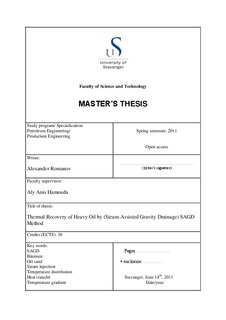| dc.contributor.author | Romanov, Alexander | |
| dc.date.accessioned | 2011-10-28T15:00:23Z | |
| dc.date.available | 2011-10-28T15:00:23Z | |
| dc.date.issued | 2011 | |
| dc.identifier.uri | http://hdl.handle.net/11250/183371 | |
| dc.description | Master's thesis in Petroleum engineering | no_NO |
| dc.description.abstract | This thesis presents experimental and numerical study of SAGD process. In spite of vast investigation done in literature for the area of steam injection, the mechanism(s) of heat flow in the reservoir are not fully understood. Understanding heat flow mechanism(s) and temperature distribution contribute to better optimization of the process and improvement of the numerical tools for simulation of SAGD process.
Experimental work and scaled numerical simulation performed to understand main key processes during SAGD. Basically, a model reservoir is constructed with heavy oil to be recovered by steam injection. Mapping of temperature/steam propagation within the model reservoir clearly demonstrates fast steam rise to the overburden and propagation horizontally at the top of reservoir away from vertical injector plan. Hence, top of reservoir becomes the second heating source for underlying layers.
Analysis of temperature distribution in the reservoir and temperature gradients around sensors shows that at interface of steam chamber convective heat transfer contributes to the heat flow. As steam chamber develops further, conduction mechanism becomes dominating.
Numerical simulation using dimensional analysis with experimental data, built in CMG’s WinProp & STARS simulator version 2009 is done to investigate objectives of this work. Comparison of simulated results illustrates that numerical model has under estimation of temperature growth in beginning of SAGD process, but at later time results become similar to experimental measurements. It is also observed that time delay of temperature propagation is not the same for each part of reservoir, but it is smaller for closest area to steam injection source, and increases with the horizontal distance from SAGD well pair.
Other quantitative parameters, such as oil recovery and water consumption, estimated from numerical simulation, show fairly good agreement with experimental measurements. | no_NO |
| dc.language.iso | eng | no_NO |
| dc.publisher | University of Stavanger, Norway | no_NO |
| dc.relation.ispartofseries | Masteroppgave/UIS-TN-IPT/2011; | |
| dc.subject | petroleumsteknologi | no_NO |
| dc.subject | produksjonteknologi | no_NO |
| dc.title | Thermal recovery of heavy oil by (steam-assisted gravity drainage) SAGD method | no_NO |
| dc.type | Master thesis | no_NO |
| dc.subject.nsi | VDP::Technology: 500::Rock and petroleum disciplines: 510::Petroleum engineering: 512 | no_NO |
